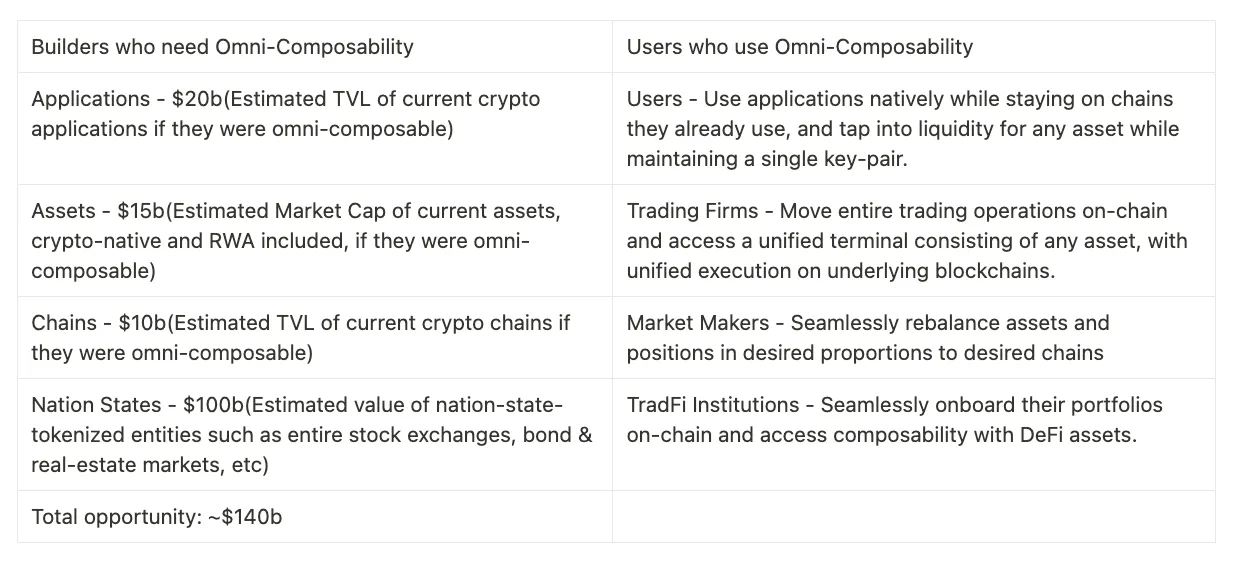What is Omni-Composability?

by Spicenet
March 18, 2025
Context
Spicenet is the Composability Middleware that allows anyone to build omni-composable applications, assets, and blockchains that can compose with any DeFi asset, liquidity pool, or market, on any blockchain network.
We created the omni-composable standard, a philosophy to build an app/asset/blockchain that can natively tap into any DeFi asset, liquidity pool, or market on a number of supported blockchain networks. In other words, use cases that can “compose with the omnichain”, and elevate their product to be native to more than one blockchain ecosystem.
In this article, we define what is omni-composability, and how do we think about omni-composability in the context of applications, assets, and blockchains.
What is Composability?
Put simply, composability is two autonomous pieces of code coordinating with each other to achieve a shared outcome. This is a high-level, abstracted definition, but in practicality, it involves smart contract A programmatically invoking smart contract B to mutate it’s state. Some cool examples of composability seen in real-life include DEX Aggregators, which are smart contracts that invoke other smart contracts(AMMs and Liquidity Pools) to execute trades.
Composability in a way is an infinite garden that allows a developer to write a fully autonomous entity(a smart contract) that can talk to and invoke other autonomous entities(other smart contracts) to execute a task, or in other words, achieve a shared outcome, which can be executing a trade.
Another example of composability is Account Abstraction(AA), wherein smart contract wallets authenticate user actions and execute the said action by invoking the specified smart contract.
Types of Composability
Composability is of broadly two types: Synchronous and Asynchronous.
Synchronous Composability(SC) allows smart contract composability in the same atomic block, hence providing better security and finalization guarantees. It ensures that transactions carrying out composability between smart contracts are atomic, meaning either they succeed at the same time or fail together.
Asynchronous Composability(AC) allows decoupled smart contract composability wherein transactions carrying out composability between smart contracts are executed in more than one block, meaning atomicity is not guaranteed. AC gives lesser security and finalization guarantees compared to SC.
Let’s also explore how SC and AC are used in modern interoperability solutions. Intra-chain composability is mostly synchronous as transactions are sequenced by one leader producing one atomic block. Inter-chain interactions, which are mostly transfers are asynchronous as transactions on the source and destination chains are sequenced by independent leaders and hence in different blocks.
As the world is increasingly going multichain, where users, developers, and applications are scattered across chains; synchronous composability across multiple blockchain networks requires coordinated, shared sequencing. Meaning that every L1, L2 and blockchain in existence would have to be sequenced by a single leader to enable multichain synchronous composability. This is an unreasonable expectation because
a. One leader cannot sequence all the blockchains in the world. Even if a leader sequences a cluster of blockchains, composability between an in-cluster blockchain and an out-of-cluster blockchain would still be asynchronous.
b. Blockchains want sovereignty over their ordering, execution, and consensus practices and do not want to commit to a single homogenous framework of transaction ordering, execution, and agreement.
What is Omni-Composability?
Omni-Composability refers to the notion that an application, or more broadly, a piece of autonomous code is composable with the omnichain, i.e with every blockchain network, and more specifically, any arbitrary state on any blockchain network.
So put in simpler terms, omni-composability refers to the ability of an autonomous smart contract to compose with any arbitrary state on any blockchain network.
Spicenet enables natively omni-composable applications, assets and even blockchains, with access to any asset, liquidity pool, or market on any blockchain network. Developers can write and deploy standard EVM smart contracts while composing with users, assets, and any arbitrary state on the blockchain networks Spicenet intends to support.
This means that applications can incorporate a diverse selection of assets backed by deep liquidity aggregated across multiple liquidity pools on various blockchain networks and offer a full-stack and integrated experience to their users. Users can access applications from any form of keypair(EVM, SVM, Move, Ton, Cosmos, etc) from blockchains they already use. Applications, hence, get better distribution to users from chains more than one.
On the other hand, they can go completely beyond just assets, liquidity pools and users and compose with any arbitrary state, such as money markets, (re)staking protocols, NFT applications, and more, to offer a differentiated and rich experience to their users.
Opportunity and Consumers of Omni-Composability
We believe that the opportunity for omni-composability is massive. Here is how we identify the opportunity:

How is Spicenet segmenting potential customers of omni-composability?

Multichain vs Omni-Composability
But, what’s the difference between a multichain application and an omni-composable application? Omni-composability is a broader term and more scalable than multichain, wherein multichain apps are to be accessed by users from multiple chains, but often require applications to re-deploy smart contracts on multiple chains, and even require users to manage multiple keypairs on various chains to participate.
In contrast, omni-composability allows developers to write and maintain a single deployment, while accessing users from any blockchain network. In tandem, users can access any omni-composable app as if it were a native app on the blockchain they use while maintaining a single keypair that allows the user to operate & spend a single balance aggregated across underlying blockchains.
Another stark & obvious difference is that omni-composability allows developers to compose with any arbitrary state on any blockchain network, including composing with liquidity pools for any asset on any supported network.
All in all If you’re building multichain, you’re better off building omni-composable.
